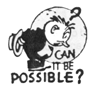|

This story was published in Radio Recall, the journal of the Metropolitan Washington Old-Time Radio Club, published six times per year.
Click here to return to the index of selected articles.
|
|
  ASK THE EXPERT... ASK THE EXPERT...
Our expert this issue is Stephen A Kallis, Jr., an OTR researcher, a licensed pilot, and the author of the most recent book on “Captain Midnight”.
(From Radio Recall, December 2002)
QUESTION: I seem to recall many references in Old Time Radio premiums to “decoder rings”. Were there really such items offered, and by which programs?
ANSWER: There never was a "decoder ring" radio premium in the OTR period. However, in 2001, an FM station in California offered a modified version of an “Ovaltine Secret Decoder Ring” But none were offered in the Golden Age of Radio, although this urban legend is beginning to take on a life in our OTR community, which should know better.
Rather than just letting it go at that, I think it would be constructive to discuss OTR "decoders." Many of these were badges; some were pocket items; and I repeat, NONE were rings.
To a cryptologist, most of the premiums weren't code devices; they were cipher items. A code is a series of letters taken as a unit, or some other symbol or representation to represent a word or phrase. Thus, the code "SOS" means "I am in trouble and need assistance," as does the spoken word, "Mayday." The skull-and-crossbones symbol on a bottle represents "poison."
By contrast, a cipher is a message where every letter of a message is replaced by another letter or a number. Using the Radio Orphan Annie Telematic Decoder Pin set at "22," the message "24-17-6-3 6-3 19 12-6-10-17-18-14" deciphers to "This is a cipher." Most of the cipher devices used number substitution for letters.
Shows that broadcast cipher messages favored the letter-number substitution. I suspect that the reason for this was because there is less chance to confuse numbers than letters (E, C, D, B, and V, for example), particularly with the delivery of someone like Pierre Andre.
Ovaltine had a thing for crypto devices. Radio Orphan Annie's pins, and Captain Midnight's Code-O-Graphs spanned fifteen years, if we include the first ROA cipher in the 1934 ROA manual. Little Orphan Annie had two more "decoders" when Quaker Puffed Wheat Sparkies picked up her sponsorship.
Additionally, Red Ryder had a "decoder," and there were a few others. Tom Mix Ralston Straight Shooters had two code offerings. The Six-Gun Decoder Badge, a 1941 premium, was a badge with a movable pointer, shaped like a revolver. Pointing the barrel to one of the icons on the front would cause a coupled pointer on the back to indicate a word or phrase. In 1946, the Tom Mix show offered a set of pinback buttons of various characters on the show. On the front was an identifying photo; on the back, a word. "Look on the back of your Mike Shaw button" meant that the answer to the question the announcer had posed was "No."
|